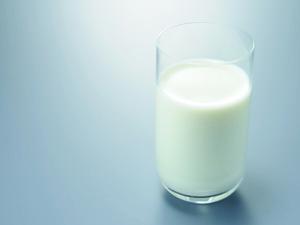
-
Milk quality

FAQ-Qualité-Q1-ANG
What is good quality milk?
Milk is healthy and meets very strict European hygiene standards. Milk quality is highly controlled, with samples are taken systematically in farms and dairy production facilities, then analysed in laboratories.
The criteria for milk quality are as follows: fat content = 38 g/L, protein = 32 g/L, germs <100,000 CFU/mL, cells <400,000/mL and no antibiotic residues or added water.

FAQ-Qualité-Q2-ANG
How often is milk collected?
Milk is collected on average every 48 hours (72 hours maximum).

FAQ-Qualité-Q3-ANG
At what temperature must milk be stored?
Milk must be stored at 4°C to preserve its healthy, organoleptic qualities.

FAQ-Qualité-Q4-ANG
How much milk is needed to make 1 kg of butter?
22 litres of milk are required to make 1 kg of butter.
-
The dairy industry

FAQ-Interprof-Q1-ANG
How is the dairy industry organized in France?
CNIEL is represented by three bodies:
- The body of milk producers : the National Federation of Dairy Farmers (FNPL) and the “Confédération paysanne” (CP) (French Farmers’ Confederation)
- The body of dairy cooperatives: the National Federation of Dairy Cooperatives (FNCL)
- The body of private dairy companies: the National Federation of Private Dairy Processors (FNIL)

FAQ-Interprof-Q2-ANG
Is there a publication that provides comprehensive facts and figures on the dairy industry?
Every year, CNIEL publishes L’Economie Laitière en Chiffres (The Dairy Economy in Figures), an overview of the dairy industry in France, as well as in Europe and worldwide. You can consult this report directly on the site in the “Key facts” section.

FAQ-Interprof-Q3-ANG
How large is the average dairy farm?
In France, the average dairy farm has 53 cows and 88 hectares of land, produces 330,000 litres of milk annually and is managed by two people (2012 figures).
-
Nutrition

FAQ-Nutrition-Q2-ANG
Do all dairy products contain calcium?
All dairy products come from the same source and therefore have the same basic ingredients, although the manufacturing process influences the final composition of each product. Cheese (especially those with hard rinds, such as Emmental) contain more calcium than milk at equal quantities. However, the amount consumed should be taken into account: we can easily drink a 100 ml glass of milk but we rarely eat 100 g of cheese! Considering the different portion sizes, dairy products all contain similar amounts of calcium.

FAQ-Nutrition-Q3-ANG
Do dairy products have an impact on cardiovascular health?
Yes, the consumption of dairy products is linked to a decrease in the risk of arterial hypertension, type 2 diabetes and metabolic syndrome. Numerous studies also show a positive impact on cardiovascular disease, especially strokes.

FAQ-Nutrition-Q4-ANG
Do dairy products help to prevent osteoporosis?
Osteoporosis is a disease that impacts the over-60s in particular, weakening the entire bone structure and increasing the risk of fractures. To prevent this and maintain bone strength, nutritionists recommend the consumption of three dairy products daily, combined with regular physical activity and a balanced diet.
In Asia, a strong increase in osteoporotic fractures has been observed for some years now. Authorities have therefore promoted the consumption of dairy products from the earliest possible age to improve bone health among the population.

FAQ-Nutrition-Q5-ANG
Is there a link between acne and dairy products?
All kinds of food, whether chocolate, meat or dairy products, are regularly blamed for skin problems, particularly acne. However, there is no proof of any link.
Adolescents have acne although they consume less milk than children, who have peachy skin!Dermatologists in no way recommend cutting out dairy products, which like other food groups, play a role in a balanced and well-proportioned diet.
-
Milk

FAQ-lait-Q1-ANG
Milk is good for children, but what about adults?
Milk, and specifically calcium, is good for bone development when we grow and at other times too! Bones are living tissues that are constantly renewed and therefore require calcium at all stages of life. Dairy products are an irreplaceable source of calcium, and dairy calcium is considered the leading source: other nutrients present in milk (protein, lactose, phosphorus and vitamin D) promote its absorption by the body. And let’s not forget that milk and dairy products are also excellent sources of zinc, iodine and vitamins A, B2 and B12.

FAQ-lait-Q2-ANG
Is milk fatty?
Milk is not fatty since it contains 90% water. Whole milk contains 3.5% fat, while semi-skimmed contains 1.5% and skimmed milk less than 0.3%. A 100 ml glass of semi-skimmed* milk therefore contains only 1.5 g of fat. It is worth noting that milk contains just as much calcium and protein whatever the fat content.
* the most popular type of milk in France

FAQ-lait-Q3-ANG
Do plant-based milks exist?
“Milk” can only be used for the product of normal mammary secretion. “Soya milk” is therefore an unauthorized use of the word “milk.” There are “plant-based drinks” or soya-based juices that naturally contain 10 times less calcium than cow’s milk. These drinks can be artificially enriched with calcium but do not contain all the components of milk, some of which promote the absorption of calcium. In addition, soya juice contains phytoestrogens, substances similar to natural hormones; this has led the French Food Safety Agency to recommend that children under three years should not drink soya-based products.

FAQ-lait-Q4
Is milk easy to digest?
Most people can digest milk, depending on the quantity. Lactase, the enzyme in charge of digesting lactose (milk sugar), is most active in infants, which is normal since they feed only on milk. Lactase activity diminishes when children expand their diets, but still remains. In France, only 6-10% of adults experience bloating or stomach ache when they drink milk on an empty stomach. Milk is easier to digest when it is included in a purée, gratin or rice pudding, or drunk during a meal.

FAQ-lait-Q5
What about allergies to cow’s milk?
Like nearly any type of food, milk can cause allergies. 1-2% of infants have an allergy to cow’s milk protein, which usually disappears at around the age of three. Allergies to cow’s milk are very rare among adults (only one in 10 children who are allergic to cow’s milk protein will continue to be allergic as an adult). A milk allergy diagnosis should always be based on specific objective, biological skin tests. Children are much less prone to milk allergies than to egg or peanut allergies.
-
Butter

FAQ-beurre-Q1-ANG
Can butter be heated or melted?
Yes, butter can be heated or melted, but it should not be overcooked. It is best to avoid blackening butter so that it preserves its nutritional qualities and flavour. Beyond 120°C, butter becomes black. To avoid this alteration, it is possible to clarify butter by melting it gently and skimming off the white foam, known as whey. Clarified butter can be kept in the fridge for up to two weeks in an airtight container.

FAQ-beurre-Q2-ANG
Is butter healthy?
Butter is often criticized for being high in saturated fat and raising cholesterol levels. However, butter is made up of a wide variety of fats: saturated fat (including short-chain saturated fat that has health benefits) and unsaturated fat (polyunsaturated and monounsaturated).
In practice, all types of fat have nutritional benefits. The important thing is to vary them: for example, olive oil for seasoning, colza oil for cooking and a knob of butter for spreading on toast.
Butter is also very rich in vitamin A, which is good for the eyes and growth: 20-25 g of butter provides around 30% of the recommended daily amount of vitamin A.
-
Fresh products

FAQ-Pdtsfrais-Q1-ANG
Are there any bacteria in yoghurt?
Yes, but they are useful bacteria! Not all bacteria are harmful – far from it. Our digestive system is home to the 100,000 billion bacteria in the intestinal flora, which is vital to good health.
Yoghurt is a very specific type of fermented milk. In France, to use the name “yoghurt”, milk must contain two specific cultures of bacteria: Lactobacillus bulgaricus and Streptococcus thermophilus. These bacteria must also be live and abundant in the end product (at least 10 million bacteria/g). Yoghurt is a live product.
These bacteria help to balance the intestinal flora, contributing to healthy intestines. In fact, they “pre-digest” sugar and promote their absorption, ward off intestinal infection and regulate bowel movements.
Most of these bacteria have long been used in products, which clearly proves their harmlessness.
-
Cheese

FAQ-fromages-Q1-ANG
Is cheese fattening?
No food has the power to make people put on or lose weight. The only thing responsible for weight gain is an excess of calories being consumed (compared to individual daily needs). Cheese has a reputation for being fatty but the amount consumed should be taken into account: a 30 g portion of Emmental contains only 9 g of fat, while a portion of Camembert contains 6 g (compared with 10 g for a tablespoon of oil), which is entirely compatible with a balanced diet. Cheeses are also an interesting source of calcium protein and vitamins...

FAQ-fromages-Q2-ANG
How much fat is there in 45% fat Camembert?
100 g of 45% fat Camembert contains 22 g of fat. This percentage refers to the quantity of fat in dry matter (cheese without the water), not the end product consumed. As 100 g of Camembert contains 50 g of water, the actual fat content is not 45 g but half that: 22 g.

FAQ-fromages-Q3-ANG
At what age can children start eating cheese?
Cheese can be eaten from the age of 6-8 months, when infants’ diets expand.
An ideal start is to give your child 10-15 g of cheese a day: for example, grated cheese in a purée or a few strips of semi-hard cheese. However, it is best to avoid raw-milk cheese before the age of three and to always remove the rind.
-
Cream

FAQ-crème-Q1-ANG
Is fresh cream a light dairy product?
Yes, fresh cream is the lightest of all forms of fat even. While 10 g of butter contains about 75 kcal (compared with 90 kcal for 10 g of oil), 10 g of cream contains only 30 kcal. Cream, whether single or double, is the lightest form of fat since it has a very high water content (70% on average).
 Everything you need to know about milk and dairy products, the different steps involved in processing them, their diversity and health benefits. Also, practical information such as how to read food labels, make homemade dairy products,…
Everything you need to know about milk and dairy products, the different steps involved in processing them, their diversity and health benefits. Also, practical information such as how to read food labels, make homemade dairy products,… All about how CNIEL serves the French dairy industry. The organization addresses a wide range of issues, from the dairy economy, international business and promotion, to technology and scientific research. Its work is aimed at helping dairy producers and processors to anticipate market developments and build a strong future.
All about how CNIEL serves the French dairy industry. The organization addresses a wide range of issues, from the dairy economy, international business and promotion, to technology and scientific research. Its work is aimed at helping dairy producers and processors to anticipate market developments and build a strong future.